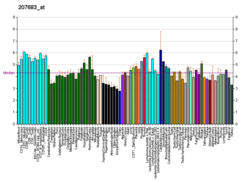FOXN1
| FOXN1 | |||||||||||||||||||||||||||||||||||||||||||||||||||
|---|---|---|---|---|---|---|---|---|---|---|---|---|---|---|---|---|---|---|---|---|---|---|---|---|---|---|---|---|---|---|---|---|---|---|---|---|---|---|---|---|---|---|---|---|---|---|---|---|---|---|---|
| Identifiers | |||||||||||||||||||||||||||||||||||||||||||||||||||
| Aliases | FOXN1, FKHL20, RONU, WHN, forkhead box N1, TIDAND, TLIND | ||||||||||||||||||||||||||||||||||||||||||||||||||
| External IDs | OMIM: 600838; MGI: 102949; HomoloGene: 2664; GeneCards: FOXN1; OMA:FOXN1 - orthologs | ||||||||||||||||||||||||||||||||||||||||||||||||||
| |||||||||||||||||||||||||||||||||||||||||||||||||||
| |||||||||||||||||||||||||||||||||||||||||||||||||||
| |||||||||||||||||||||||||||||||||||||||||||||||||||
| |||||||||||||||||||||||||||||||||||||||||||||||||||
| |||||||||||||||||||||||||||||||||||||||||||||||||||
| Wikidata | |||||||||||||||||||||||||||||||||||||||||||||||||||
| |||||||||||||||||||||||||||||||||||||||||||||||||||
Forkhead box protein N1 is a protein that in humans is encoded by the FOXN1 gene.[5][6]
Function
Mutations in the winged-helix transcription factor gene at the nude locus in mice and rats produce the pleiotropic phenotype of hairlessness and athymia, resulting in a severely compromised immune system. This gene is orthologous to the mouse and rat genes and encodes a similar DNA-binding transcription factor that is thought to regulate keratin gene expression. A mutation in this gene has been correlated with T-cell immunodeficiency, the skin disorder congenital alopecia, and nail dystrophy. Alternative splicing in the 5' UTR of this gene has been observed.[6] In the chick embryo, the FOXN1 gene is expressed in the developing thymus, claws and feathers. The expression of FOXN1 in feathers and claws indicates that it may regulate the feather outgrowth. In feather and claws, FOXN1 can potentially regulate expression of keratins similar to mammalian orthologs. [7] In thymic epithelial cells, FOXN1 has been shown to bind to and regulate genes involved in T-cell maturation and antigen presentation.[8]
References
- ^ a b c GRCh38: Ensembl release 89: ENSG00000109101 – Ensembl, May 2017
- ^ a b c GRCm38: Ensembl release 89: ENSMUSG00000002057 – Ensembl, May 2017
- ^ "Human PubMed Reference:". National Center for Biotechnology Information, U.S. National Library of Medicine.
- ^ "Mouse PubMed Reference:". National Center for Biotechnology Information, U.S. National Library of Medicine.
- ^ Schorpp M, Hofmann M, Dear TN, Boehm T (Dec 1997). "Characterization of mouse and human nude genes". Immunogenetics. 46 (6): 509–15. doi:10.1007/s002510050312. PMID 9321431. S2CID 32175138.
- ^ a b "Entrez Gene: FOXN1 forkhead box N1".
- ^ Darnell DK, Zhang LS, Hannenhalli S, Yaklichkin SY (Dec 2014). "Developmental expression of chicken FOXN1 and putative target genes during feather development". The International Journal of Developmental Biology. 58 (1): 57–64. doi:10.1387/ijdb.130023sy. PMID 24860996.
- ^ Žuklys S, Handel A, Zhanybekova S, Govani F, Keller M, Maio S, Mayer CE, Teh HY, Hafen K, Gallone G, Barthlott T, Ponting CP, Holländer GA (Aug 2016). "Foxn1 regulates key target genes essential for T cell development in postnatal thymic epithelial cells". Nature Immunology. 17 (10): 1206–15. doi:10.1038/ni.3537. PMC 5033077. PMID 27548434.
Further reading
- Zhang Z, Burnley P, Coder B, Su DM (2012). "Insights on FoxN1 biological significance and usages of the "nude" mouse in studies of T-lymphopoiesis". International Journal of Biological Sciences. 8 (8): 1156–67. doi:10.7150/ijbs.5033. PMC 3477685. PMID 23091413.
- Mecklenburg L, Tychsen B, Paus R (Nov 2005). "Learning from nudity: lessons from the nude phenotype". Experimental Dermatology. 14 (11): 797–810. doi:10.1111/j.1600-0625.2005.00362.x. PMID 16232301. S2CID 27700105.
- Nehls M, Pfeifer D, Schorpp M, Hedrich H, Boehm T (Nov 1994). "New member of the winged-helix protein family disrupted in mouse and rat nude mutations". Nature. 372 (6501): 103–7. Bibcode:1994Natur.372..103N. doi:10.1038/372103a0. PMID 7969402. S2CID 2656526.
- Frank J, Pignata C, Panteleyev AA, Prowse DM, Baden H, Weiner L, Gaetaniello L, Ahmad W, Pozzi N, Cserhalmi-Friedman PB, Aita VM, Uyttendaele H, Gordon D, Ott J, Brissette JL, Christiano AM (Apr 1999). "Exposing the human nude phenotype". Nature. 398 (6727): 473–4. Bibcode:1999Natur.398..473F. doi:10.1038/18997. hdl:2299/16173. PMID 10206641. S2CID 107413.
- Gattenlöhner S, Müller-Hermelink HK, Marx A (1999). "Transcription of the nude gene (WHN) in human normal organs and mediastinal and pulmonary tumors". Pathology, Research and Practice. 195 (8): 571–4. doi:10.1016/s0344-0338(99)80007-7. PMID 10483588.
- Schlake T, Schorpp M, Maul-Pavicic A, Malashenko AM, Boehm T (Apr 2000). "Forkhead/winged-helix transcription factor Whn regulates hair keratin gene expression: molecular analysis of the nude skin phenotype". Developmental Dynamics. 217 (4): 368–76. doi:10.1002/(SICI)1097-0177(200004)217:4<368::AID-DVDY4>3.0.CO;2-Z. PMID 10767081.
- Adriani M, Martinez-Mir A, Fusco F, Busiello R, Frank J, Telese S, Matrecano E, Ursini MV, Christiano AM, Pignata C (May 2004). "Ancestral founder mutation of the nude (FOXN1) gene in congenital severe combined immunodeficiency associated with alopecia in southern Italy population". Annals of Human Genetics. 68 (Pt 3): 265–8. doi:10.1046/j.1529-8817.2004.00091.x. PMID 15180707. S2CID 20067101.
- Janes SM, Ofstad TA, Campbell DH, Watt FM, Prowse DM (Aug 2004). "Transient activation of FOXN1 in keratinocytes induces a transcriptional programme that promotes terminal differentiation: contrasting roles of FOXN1 and Akt" (PDF). Journal of Cell Science. 117 (Pt 18): 4157–68. doi:10.1242/jcs.01302. PMID 15316080. S2CID 9153395.
- Nonaka D, Henley JD, Chiriboga L, Yee H (Jul 2007). "Diagnostic utility of thymic epithelial markers CD205 (DEC205) and Foxn1 in thymic epithelial neoplasms". The American Journal of Surgical Pathology. 31 (7): 1038–44. doi:10.1097/PAS.0b013e31802b4917. PMID 17592270. S2CID 30502411.
- Weiner L, Han R, Scicchitano BM, Li J, Hasegawa K, Grossi M, Lee D, Brissette JL (Sep 2007). "Dedicated epithelial recipient cells determine pigmentation patterns". Cell. 130 (5): 932–42. doi:10.1016/j.cell.2007.07.024. PMID 17803914. S2CID 14622851.
- v
- t
- e
(1) Basic domains | |||||||||||||||||||||||||
|---|---|---|---|---|---|---|---|---|---|---|---|---|---|---|---|---|---|---|---|---|---|---|---|---|---|
| |||||||||||||||||||||||||
(2) Zinc finger DNA-binding domains | |||||||||||||||||||||||||||
|---|---|---|---|---|---|---|---|---|---|---|---|---|---|---|---|---|---|---|---|---|---|---|---|---|---|---|---|
| |||||||||||||||||||||||||||
(3) Helix-turn-helix domains | |||||||||||||||||||||
|---|---|---|---|---|---|---|---|---|---|---|---|---|---|---|---|---|---|---|---|---|---|
| |||||||||||||||||||||
(4) β-Scaffold factors with minor groove contacts | |||||||||||||||||||
|---|---|---|---|---|---|---|---|---|---|---|---|---|---|---|---|---|---|---|---|
| |||||||||||||||||||
(0) Other transcription factors | |||||||||
|---|---|---|---|---|---|---|---|---|---|
| |||||||||
 | This article on a gene on human chromosome 17 is a stub. You can help Wikipedia by expanding it. |
- v
- t
- e

















